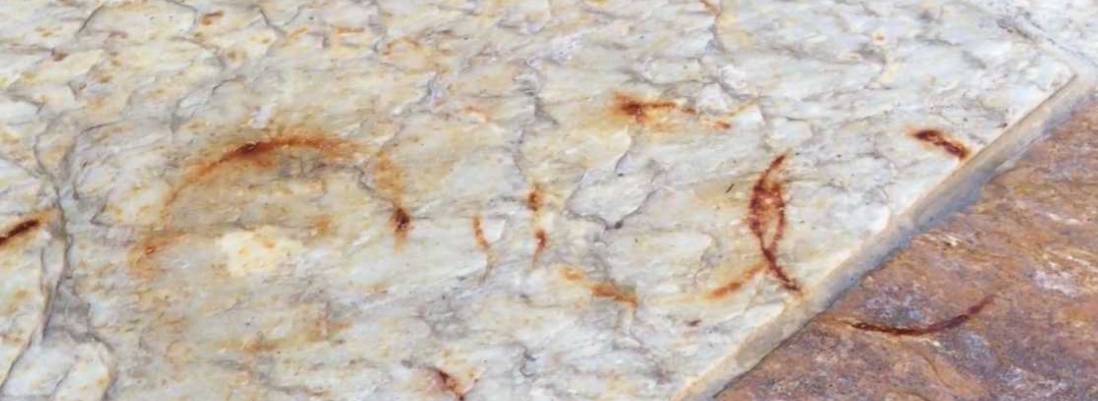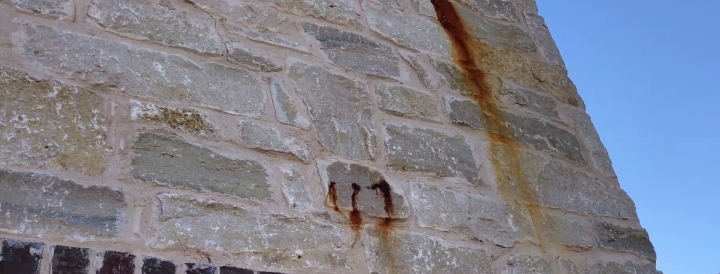Stone surfaces bring timeless beauty and significant value to any property. However, unsightly rust stains are a common and stubborn problem. These stains not only mar the appearance of your stone but can also be challenging to remove. Traditional cleaning methods often fall short, providing incomplete results or, worse, causing irreversible damage to the stone itself. Laser cleaning technology emerges as a groundbreaking alternative. This advanced method precisely targets and removes rust. Importantly, it keeps your valuable stone safe from harm. This article delves into laser cleaning for stone. We explore how it works, its benefits, and considerations to help you decide if it’s the right solution for your rust-stained stone.
Understanding Rust Stains on Your Stone
Rust stains on stone can be frustrating. Understanding their origin helps in tackling them. Stone can develop rust for several reasons. Some stones naturally contain iron particles. Exposure to moisture and air causes these particles to oxidize, forming rust. External metal objects are another common culprit. Metal furniture, railings, planters, or tools left on stone can corrode. Water runoff from these metal items also deposits rust. Even water from sprinklers, if high in iron, can stain stone over time.
Rust does more than just look bad. It penetrates the porous structure of many stones. This makes removal difficult. If left untreated, deep-seated rust can sometimes contribute to the gradual weakening of the stone, though primarily it’s an aesthetic issue. Effective rust removal means addressing these penetrated stains without damaging the stone’s surface or integrity.
How Laser Cleani Works on Stone Rust
Laser cleaning offers a high-tech solution to rust stains. It uses concentrated light energy to clean stone. The process is quite precise. Special lasers direct beams of light at the rust. The rust, being darker than most stone, readily absorbs this light energy.
This absorption causes the rust to heat up incredibly quickly. The intense, localized heat forces the rust particles to expand and vaporize, or essentially break free from the stone’s surface. These tiny particles are then lifted away, often collected by a specialized vacuum system. This cleaning mechanism is known as photothermal ablation, but simply put, the laser light makes the rust disappear.
A key advantage is selectivity. The laser light is chosen so the rust absorbs it, but the stone itself reflects most of it or absorbs very little. This means the stone surface remains significantly cooler. It avoids damage like melting, cracking, or discoloration. Professionals carefully adjust laser settings. These settings include power levels and light characteristics (wavelength). This ensures the rust is removed effectively. The underlying stone remains untouched and preserved.
Laser Cleaning vs. Chemical Cleaners for Stone
When facing rust on stone, many consider chemical cleaners. It’s useful to compare this older method with modern laser cleaning. Chemical cleaners typically use strong acids or potent chelating agents. These substances work by dissolving the rust or chemically altering it to loosen its bond with the stone. Laser cleaning, in contrast, uses pure light energy. It physically removes the rust particles. No chemicals are involved in the laser process.
A major difference is the risk of damage. Chemicals, especially acids, can easily etch, dull, or discolor sensitive stones like marble, limestone, or even some granites. The reaction can be hard to control. Lasers, when operated correctly by a trained professional, are much gentler. They target the rust selectively, minimizing interaction with the stone.
Another point is residues. Chemical treatments often leave residues within the porous stone. These residues can attract dirt or cause new stains if not thoroughly rinsed away. Rinsing itself can sometimes be problematic, introducing excessive moisture. Laser cleaning is a dry process. It leaves no chemical mess or harmful residues.
Regarding safety, chemical rust removers can be hazardous. They may produce strong fumes or cause skin burns. Users need robust protective gear. Laser cleaning avoids these chemical hazards. The main safety measures for lasers involve protecting eyes from the light and using fume extractors to capture the fine dust created from the ablated rust. This generally means a safer environment for the operator and the surroundings.
Finally, effectiveness and precision differ. Lasers offer pinpoint accuracy. They can remove rust from tiny spots or intricate patterns without affecting adjacent areas. Chemicals spread and can be harder to control precisely. For deep or very stubborn rust, lasers can often achieve more complete removal layer by layer.
Key Benefits of Laser Rust Removal for Your Stone
Laser cleaning brings several compelling advantages for restoring rust-stained stone surfaces. These benefits make it an increasingly preferred method, especially for valuable or delicate stone.
Precision Cleaning Protects Stone: Lasers target only the rust. The focused light interacts with the stain, leaving the surrounding stone untouched. This means your stone’s original surface, texture, and polish are preserved. There are no scratches, abrasions, or wear typically associated with harsh scrubbing or abrasive methods.
Complex Shapes Are No Obstacle: Many stone items feature detailed carvings, intricate patterns, or hard-to-reach areas. Traditional cleaning methods often struggle to address rust in these complex geometries uniformly. Laser cleaning excels here. Handheld laser devices allow operators to direct the cleaning energy precisely, even into deep recesses or around delicate features of statues, ornamental stonework, or detailed facades.
Effectively Handles Deep-Set Rust: Rust often penetrates beneath the stone’s immediate surface. Laser cleaning can address this by removing rust layer by layer. Operators adjust laser settings to control the depth of ablation. This gradual removal ensures that even embedded rust is treated without significant excavation or damage to the sound stone material beneath.
An Eco-Friendly Cleaning Choice: Environmental concerns are increasingly important. Laser cleaning is a greener option. It uses no harsh chemical solvents, acids, or detergents. This eliminates the problem of chemical runoff or contaminated waste disposal. The main byproduct is a small amount of dry particulate dust from the rust, which is typically captured by an integrated vacuum system.
Safer for Users and Occupants: By avoiding aggressive chemicals, laser cleaning creates a healthier environment for the system operator and any occupants of the property. There are no noxious fumes from solvents or risks of chemical burns. While laser operation requires strict safety protocols, such as protective eyewear, these manage predictable physical hazards rather than persistent chemical ones.
Laser Cleaning Compared: A Look at All Options
Many methods exist to remove rust from stone. Laser cleaning is a modern option. Traditional methods include chemical poultices, mechanical scrubbing (like sanding or grinding), and acidic cleaners. Each method has its place, but also its drawbacks, especially for delicate or valuable stone.
Here’s a brief comparison:
Laser Cleaning: This method uses light to remove rust. It is very precise. It is generally safe for the stone when done by a professional. No chemicals are used. The main downsides are the higher cost of the service, as the equipment is expensive, and the need for skilled operators.
Chemical Poultices: These are pastes applied to the stone. They contain chemicals that draw out or dissolve the rust. Poultices can be effective for some stains. However, they often require long waiting times (hours or days). They can be messy to apply and remove. The chemicals involved can sometimes harm the stone or leave residues. Thorough rinsing is essential.
Mechanical Abrasion (Scrubbing/Grinding): This involves physically removing the rust by scrubbing, sanding, or grinding the stone surface. While it can remove rust, it almost always damages the stone itself. It can remove the stone’s polish, alter its texture, and cause visible scratches. This method is generally too aggressive for most decorative or heritage stones.
Acidic Cleaners: Some cleaners use strong acids to dissolve rust. Acids react quickly with rust. However, they also react strongly with many types of stone, especially calcium-carbonate-based stones like marble, limestone, and travertine. This can cause severe etching, pitting, and permanent damage. Using acids on stone is very risky and usually not recommended.
A Practical Example: Laser vs. Chemical Paste on [Marble/Granite] Imagine tough, old rust stains on a valuable [marble statue/granite countertop]. Using old methods like harsh scrubbing could easily scratch it. Aggressive chemicals might etch its surface. In a comparative test, laser cleaning was pitted against a common chemical rust-removing paste.
The laser system was carefully calibrated. It directed light pulses onto the rust. The rust quickly disappeared, pass by pass. The [marble/granite] underneath was revealed, clean and bright. Close inspection, even under magnification, showed no damage. The stone’s original character was perfectly preserved.
Next, the chemical paste was applied to a similar rust stain. It was left for the recommended time, then removed and rinsed. The paste did lighten the rust. However, some faint staining remained, especially where the rust was deep. More concerning, the stone’s surface where the paste sat appeared slightly duller than the surrounding area. This suggested minor chemical alteration.
The laser treatment was also faster in terms of active work and immediate results. It was a cleaner process overall, with no messy residues to manage. This kind of comparison often shows that while lasers might require more initial investment for professionals, they can deliver superior results, especially when stone preservation is critical.
Important Points Before Choosing Laser Cleaning
Laser cleaning has many benefits for removing rust from stone. But there are some important things to think about before choosing it.
The Cost Factor: Professional laser cleaning can cost more than chemical treatments or doing it yourself. The laser machines are expensive. Skilled workers are needed to run them safely. This makes the service price higher. Still, if the stone is valuable or old, the cost can be worth it. Laser cleaning gives better results and helps avoid damage. It might save money in the long run by stopping bigger repairs later.
Professional Skill is Essential: Laser cleaning is not something you should try at home. It takes special training to use the machines right. Experts know how lasers work with different stones and rust types. They carefully set power, speed, and other settings. If someone untrained tries it, they might hurt the stone or not clean it well. Always hire a trusted company with experienced workers.
Stone Type Matters – Especially Colored Stone: Laser cleaning works great on many stones, especially light-colored ones. Rust shows up clearly on them, so the laser can target it well. But some stones need more care. Dark or colored stones, like some granites or marbles, can be tricky. Their colors might absorb laser light and cause fading or spots. Professionals do small tests on hidden spots first. This makes sure the laser settings are safe and will work for your stone.
The Future: What’s Next for Laser Stone Cleaning?
Laser cleaning technology for stone is already impressive. But it keeps getting better. Researchers and engineers are always working to make these systems easier to use and more efficient. Some exciting new developments are coming soon.
Even Better and Gentler Lasers: Future lasers, called “ultrafast” lasers, will be gentler on stone. They use very short bursts of light. This means less heat reaches the stone. That lowers the chance of damage almost to zero. These lasers might also clean faster and work on more types of stains.
Smarter, Automated Technology: Imagine a laser that can “see” the rust and knows exactly when to stop. This is becoming real with special sensors. These sensors check the stone while cleaning. The laser can then adjust itself or stop right when the rust is gone. This stops over-cleaning and gives better results every time.
More Automation for Large Projects: Big stone surfaces, like building walls or floors, could be cleaned by robots. These robots would guide the laser along set paths. This makes cleaning large areas faster and more precise. It also keeps workers safer by reducing how much they need to be near the laser.
These improvements aim to make laser cleaning safer, more accurate, and maybe cheaper over time. As the technology grows, it will likely become a popular choice for tough stone cleaning jobs.
Conclusion: Is Laser Cleaning the Right Choice for Your Stone Rust?
Laser cleaning offers a powerful and advanced solution for removing rust stains from stone. Its ability to precisely target rust without damaging the underlying stone is a significant advantage over many older methods. It is a non-contact, chemical-free process. This makes it safer for your stone, for people, and for the environment.
However, it’s important to weigh the considerations. Professional laser cleaning services typically involve a higher cost than DIY chemical kits or basic cleaning methods. The need for highly trained and experienced operators is crucial for safety and to achieve the best results. It is not a DIY solution. While effective on many stones, careful testing is always required, especially for colored or sensitive stone types.
So, when is laser cleaning the ideal choice? It is particularly well-suited for:
Valuable or delicate stone surfaces where preservation is key.
Stubborn or deeply penetrated rust stains that traditional methods can’t fix.
Situations requiring a gentle, non-abrasive, and chemical-free approach.
Intricate or complex stone features where precision is essential.
Laser technology is continually improving. It is steadily changing the landscape of stone care and restoration. If you’re facing a challenging rust problem on your stone, consulting with a professional laser cleaning specialist could be your best step towards safely restoring its natural beauty.
Post time: May-22-2025












